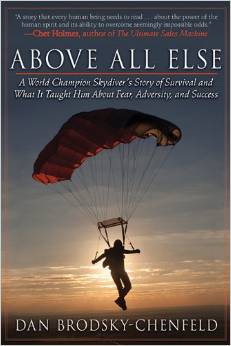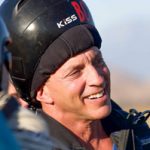The fourteenth chapter in Dan BC’s 4-way manual… Adding speed – Levels Two, Three and Four Random Work

LEVEL TWO RANDOM WORK
After training Level One Randoms Stop Drills (see previous article), on level two jumps we actually change very few things.
On stop drills we freeze in position and stay off grips long enough to show a no contact formation to the judges as if we were being scored for it. We then synchronize the build by picking up grips only when the centers decide it is time to do so.

ON LEVEL TWO JUMPS we do almost the same plan.
- While in the completed formation we anticipate the next move and look to the key person.
- We see the key and flash with both hands.
- We move as aggressively as we can control to our next position.
- We hold our eye contact during the entire move until we are stopped in position.
- We are completely aware of the entire team because we held our eye contact so long.
- We park in position while maintaining our eye contact.
- We see the pre-finished picture and anticipate the next point before picking up our grips.
- GRIPS. Here is the difference. On level two jumps we no longer show a no contact formation or wait until everyone is stopped before picking up our grips. Each individual must make a complete stop, but once that individual is stopped they can pick up grips as the grips present themselves.
Grips are still taken efficiently and we communicate our readiness through them. Our hands now pick up grips with a certain degree of muscle memory. We are able to look less directly at the grips and better utilize our peripheral vision.
The grip-taking is not as synchronized because some flyers have shorter moves. Some parts of the formation are stopped and grips presented prior to others. But having done the stop drill training we are now completely aware of the team and know with certainty if we can pick up grips earlier without hindering the build. Now we can actually assist the build by picking up grips earlier.
On level one jumps we were already moving at our maximum speed. With level two jumps we are not trying to go any faster. We are scoring more points by being more efficient and not spending as much time in the process of building each point. Level two jumps actually feel easier and less forced. A nice team pace begins to take shape and the random work starts developing a consistent rhythm to it.
Level two jumps are calm, aggressive, controlled and predictable. The skills we have invested so much time working on are now beginning to happen instinctively for us.
- We naturally hold our eye contact during the transition because it would seem crazy to look anywhere else.
- We always fly as aggressively as we can because we’ve never done it any other way.
- We automatically complete each aggressive move with a sharp stop.
- Our hands instinctively pick up good grips because that’s the only way they have ever done it.
Now it’s time to trust these instincts we’ve trained and let them work for us.

LEVEL THREE RANDOM WORK
On level three jumps we hold our eye contact long enough to see that the team has done a clean break and then get the grips.
At this point we will not sacrifice any degree of awareness by holding our eye contact for a shorter time. In the time it takes to see a clean break the team will have started to move. We will have recognized how the transition is going and will know if the build will happen quickly or if there is a glitch that may slow it down. We still see the pre-finished picture with just as much certainty but it comes during the transition rather than after the stop.
Our anticipation is better than ever and happens automatically. We instinctively know to hold our eye contact as long as practical, while also taking the grips as soon as they become available.
A simple rule as when to look at your grips is this: don’t look at or try to pick up a grip before it is within reach.
Don’t look at or try to pick up a grip before it is within reach”
In level three we are still not “trying” to go faster. The points are coming much quicker because we are flying with maximum efficiency, and minimal wasted time.
On Level One we had to consciously think to move aggressively, stop hard, hold our eye contact, anticipate at the pre-finished picture and pick up solid grips. Now we have trained all these skills to the point that they have become muscle memory. When our minds are calm, and focused we are on the line. And when we are on the line all of this happens automatically, instinctively.
The team pace has accelerated on its own but still feels calm, sharp and aggressive. Now we are ready to add speed…

LEVEL FOUR RANDOM WORK
Now it’s time to up the ante. We’ve squeezed every point we could out of becoming a technically proficient team. Our skills have been steadily advancing and the speed we are capable of increasing. From the beginning we have always been flying as aggressively as we thought we could control. Now it’s time to push further and risk being less under control.
We push the team to a new speed by predetermining a faster pace”
On levels two and three we let our style of skydiving establish a consistent team pace. Now it’s time to use that pace as a tool. On level four we push the team to a new speed by predetermining a faster pace that we will decide the team will move at.
We no longer need to focus as much on looking and stopping, those happen naturally for us. We see the key and the clean break, then pick up the grips of the next formation based on the team’s new predetermined pace. We still have to be disciplined and allow the key person to key the points. But the key person has permission to key on pace instead of on completion. If you weren’t on grips when the key came you were too slow.
If you weren’t on grips when the key came you were too slow”
SPRINT DRILLS
The most productive way of executing Level Four jumps is by doing them first as 5-point sprints. On these jumps you pause at the first point and allow the team to take a breath and prepare to fire through the sequence. On the key you race through the 5 points at the new predetermined faster pace, then pause to catch your breath again at the first point.
Doing the sprints provides the chance to experience the new pace in smaller, more manageable increments. After having successfully done the sprints on the first jump we are more prepared to hold that pace together for a full 35 seconds on the repeat jump. If we had first tried to do the entire jump at this new pace it is very likely that the team would have come completely apart early in the skydive and not had the chance to become comfortable at this new speed.
When pushing the pace it is common for the scores to stay about the same or even go down. There are often busts or glitches that cost time and points. But in the process it has shown us that we were capable of going faster than we had previously thought.
After doing a chunk of level four jumps, return back to the level three plan of moving at full speed while not consciously pushing the speed. We don’t need to push it any longer because the time spent on the sprint drills has allowed us to become comfortable at the new speed.
The Level Four training will have made us comfortable being over the line. It is likely that we will have lost touch with just how calm we need to be in order to trust our instincts and fly right on the line.
We must now calm ourselves down by putting our focus back on the four Cs. Our instincts are well trained and we are comfortable at our maximum speed. Trust that when the team calms down, and establishes good communication the speed will take care of itself.
Let the eye contact and communication dictate the speed. Don’t allow the speed to dictate the quality of the communication.
Photos in this article show Perris Fury
More Magic From Dan
Previous Article (13): Randoms, Level 1
Next Article (15): Block Training
Above All Else

Several articles in this series are extracts from Dan’s amazing book, ‘Above All Else’, which covers far more than skydiving. It’s available from Square One HERE or Amazon HERE, where you can check the glowing reviews, mostly from non skydivers, such as:
“I can’t recommend the book more. Do yourself this favor and just read it. Sure, it’s not Shakespeare, but it’s truth. At 120 MPH. And you will be forever changed.”
Amazon review by Esta Desa



